Introduction
In the rapidly evolving landscape of modern business, Robotic Process Automation (RPA) stands out as a game-changing technology that reshapes how organizations operate. By automating repetitive and rule-based tasks, RPA not only enhances productivity but also liberates human resources to focus on strategic initiatives that drive growth and innovation. This article delves into the core principles of RPA, the vital role of RPA developers, and the myriad benefits that come with its implementation.
Additionally, it addresses common challenges organizations face during RPA adoption and looks ahead to the future trends that promise to further revolutionize the automation landscape. With practical insights and compelling case studies, this exploration equips leaders with the knowledge to harness RPA effectively, ensuring their organizations thrive in an increasingly automated world.
Understanding the Fundamentals of Robotic Process Automation (RPA)
Robotic Process Automation (RPA) is a transformative technology that enables entities to automate repetitive, rule-based tasks typically executed by human workers. By deploying innovative tools like EMMA RPA and Microsoft Power Automate, RPA significantly streamlines workflows, minimizes errors, and boosts overall productivity, ultimately enhancing employee morale.
RPA solutions specifically address challenges such as task repetition fatigue and staffing shortages, allowing organizations to allocate their human resources to more strategic tasks. For instance, Nividous Bots troubleshoot 200-300 video units and cameras daily, showcasing the technology’s efficiency in handling complex tasks.
A recent implementation of a centralized automated business process management system for loan disbursement at a growing bank reduced turnaround time by 78%, illustrating the substantial operational improvements that RPA can achieve. Understanding the foundational principles of RPA is crucial for those new to the technology, as this knowledge lays the groundwork for exploring its advanced applications and benefits.
As emphasized by Nividous, ‘The Nividous Intelligent Integration platform assists businesses in progressing beyond isolated processes by offering a thorough blend of technologies that are inherent to the platform.’ This comprehensive method not only boosts operational efficiency but also meets the changing needs of contemporary businesses, as demonstrated in the case study of a mid-sized company that enhanced efficiency by mechanizing data entry, software testing, and legacy system integration using GUI methods.
The implementation resulted in a 70% reduction in data entry errors, a 50% acceleration in testing processes, and an 80% improvement in workflow efficiency, revolutionizing processes in healthcare service delivery. Furthermore, the incorporation of RPA is visually depicted by a stylized illustration of a human figure working alongside robotic figures, symbolizing the synergy between human intelligence and technology.
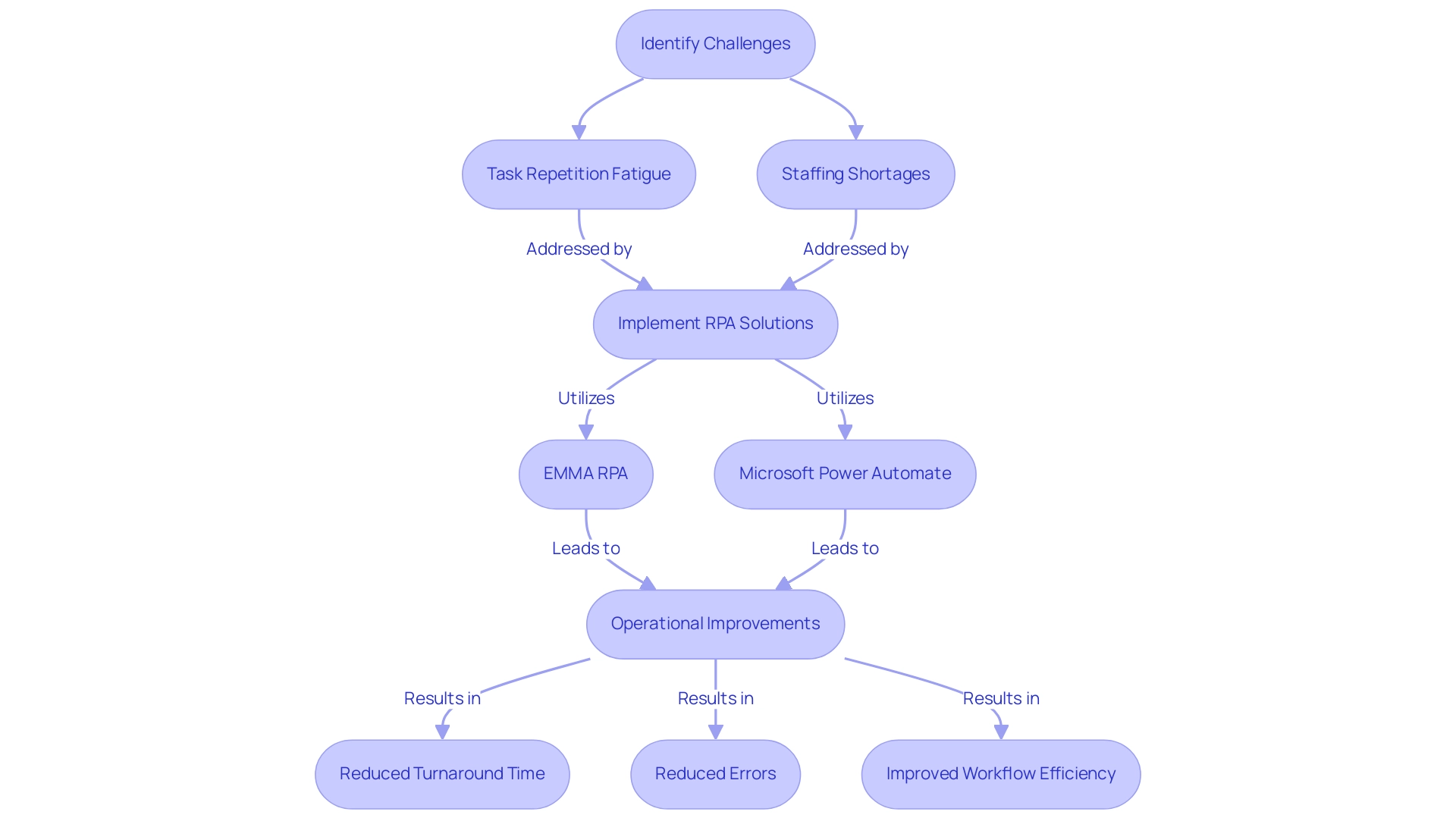
The Role of an RPA Developer: Skills and Responsibilities
An RPA developer is essential to the successful implementation and ongoing maintenance of automated solutions within an organization, addressing common workplace challenges such as repetitive tasks, outdated systems, and talent retention in operational roles. Their main duties involve:
- Examining business operations to identify areas suitable for mechanization.
- Creating and building RPA workflows.
- Thoroughly testing and implementing scripts.
With the increasing complexity of operational demands, leveraging RPA can significantly enhance productivity and operational efficiency by modernizing outdated systems. According to recent data, the average salary of RPA developers varies by region, with professionals in North America earning approximately $100,000 annually, while those in Europe average around $70,000.
To excel in this role, developers must be proficient in programming languages such as Python and Java and have a solid grasp of RPA tools like UiPath and Blue Prism. As noted by RPA expert John Doe, ‘Strong problem-solving skills are essential for developers to troubleshoot and optimize automated processes effectively.’ Furthermore, effective communication is essential, as RPA developers frequently collaborate with business analysts and stakeholders to ensure that initiatives align with business objectives.
Aspiring developers should prioritize honing these skills to navigate the expanding landscape of RPA successfully. As the industry evolves, continuous learning and adaptation remain vital, reinforcing the message that development is at the heart of RPA. For example, the case study titled ‘The Importance of Development in RPA’ demonstrates how entities that emphasize development skills in their RPA teams unleash greater efficiency potential.
Additionally, services like ApiX-Drive facilitate integration with existing systems, allowing users to create their own integrations without requiring programming expertise—a significant advantage in today’s fast-paced business environment.
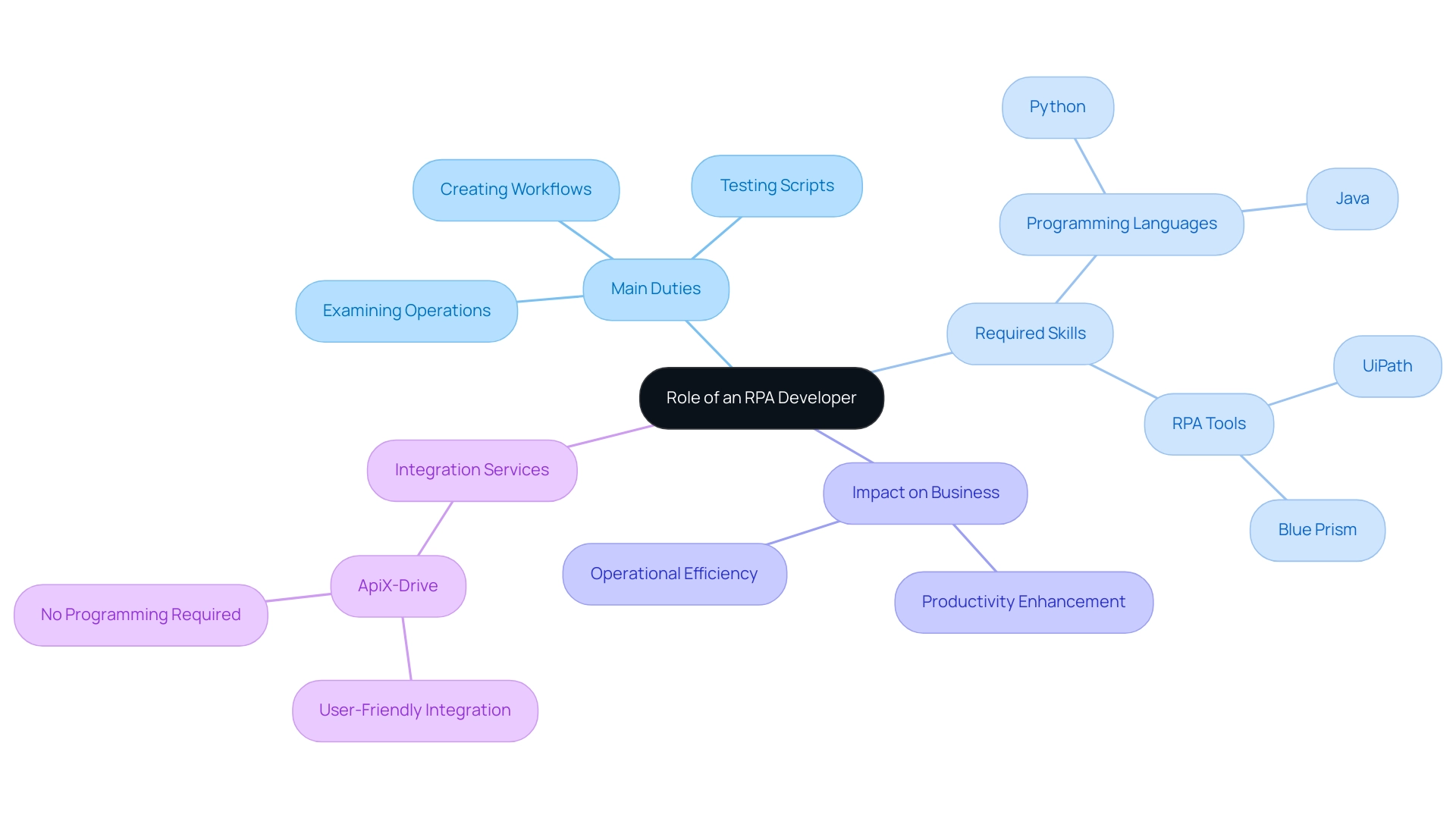
Benefits of Implementing RPA in Organizations
The adoption of Robotic Process Automation (RPA) within organizations unlocks a range of transformative benefits that drive operational excellence. A mid-sized healthcare company faced significant challenges, including:
- Manual data entry errors
- Slow software testing
- Difficulty integrating outdated systems without APIs
The execution of GUI scripting resolved these issues, leading to:
- A 70% decrease in data entry mistakes
- A 50% speedup in software testing activities
- An 80% enhancement in workflow efficiency—realizing a return on investment within only six months.
Furthermore, 85% of respondents in a Deloitte Global RPA Survey reported that RPA met or exceeded their expectations in accuracy, timeliness, and flexibility. By automating routine and mundane tasks, employees can shift their focus to more strategic initiatives, fostering innovation and growth. This shift not only enhances productivity but also boosts job satisfaction, as demonstrated by Deutsche Bank’s experience with back-office improvements, allowing their workforce to concentrate on higher-level functions.
As a representative from Deutsche Bank stated, ‘Deutsche Bank gains the advantage of RPA in various back-office process streamlining,’ highlighting the positive impact on their operations. Additionally, RPA significantly improves compliance and minimizes the risk of human error, as software robots consistently adhere to predefined rules.
The case study of Allianz showcases RPA’s application in cybersecurity, where it was utilized to bolster defenses by automating tasks such as vulnerability scanning and incident response, drastically reducing human errors and improving the capability to detect and handle cyber threats. Organizations also experience rapid scalability, enabling them to swiftly adapt to fluctuating business demands. The transformative effect of GUI automation in healthcare service delivery is evident, as it positions advocates for RPA solutions as key drivers of operational efficiency within their entities.
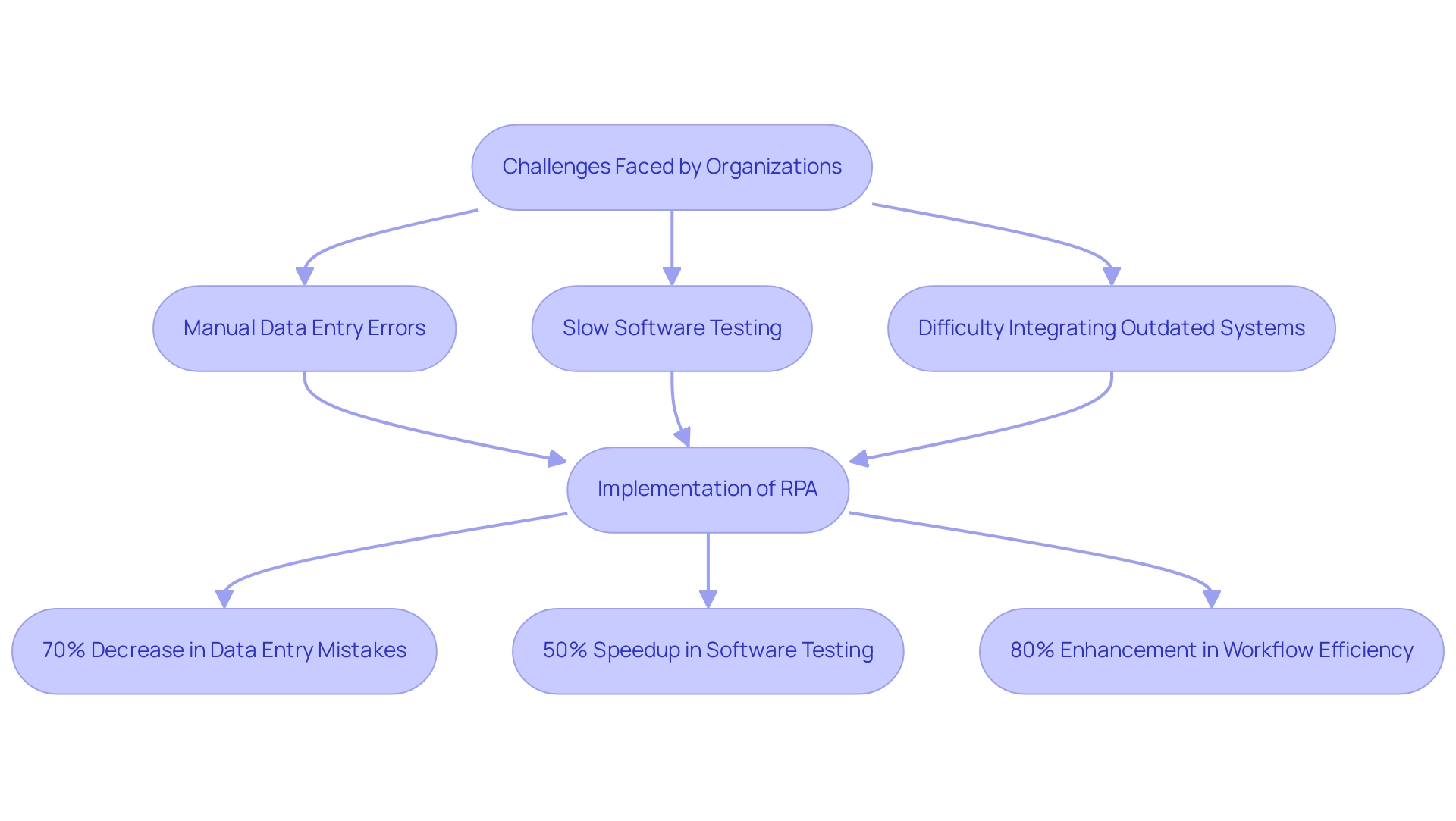
Common Challenges in RPA Implementation
Implementing Robotic Process Automation (RPA) can be transformative, yet organizations often face significant hurdles. One prevalent challenge is employee resistance to change, as many fear job displacement or are uncertain about new technologies. A survey on employee attitudes towards RPA adoption revealed that approximately 60% of employees expressed concerns about job security, highlighting this resistance as a key barrier.
Moreover, insufficient documentation and challenges in integrating RPA with existing systems can hinder progress. For instance, a case study from a leading financial services firm demonstrated that initial resistance was overcome by implementing a comprehensive training program, which led to a 40% increase in employee buy-in and successful integration of RPA into their workflows.
RPA not only streamlines operations but also enhances productivity and reduces costs by automating manual tasks, allowing teams to focus on higher-value activities. To effectively navigate these obstacles, it is crucial to cultivate a culture of collaboration and open communication. Ensuring employees are well-informed about the advantages of RPA fosters acceptance and enthusiasm for the technology.
Furthermore, meticulous process mapping and documentation are vital for identifying opportunities for mechanization and smoothing the implementation journey. Insights from industry leaders suggest that tailoring communication strategies to address specific employee concerns can significantly enhance individual programs. Additionally, integrating Business Intelligence tools can further empower companies to make informed decisions based on data insights, driving growth and innovation.
As Arumugam Subramanyam, RPA AI Architect at Automation Anywhere, aptly notes, ‘the true power lies not in the technology alone but in the human ability to dream, strategize, and lead the orchestration of workflows.’ By proactively tackling these challenges and utilizing Business Intelligence alongside RPA, entities can establish a pathway for successful implementation, merging technology and human creativity to enhance efficiency and innovation.
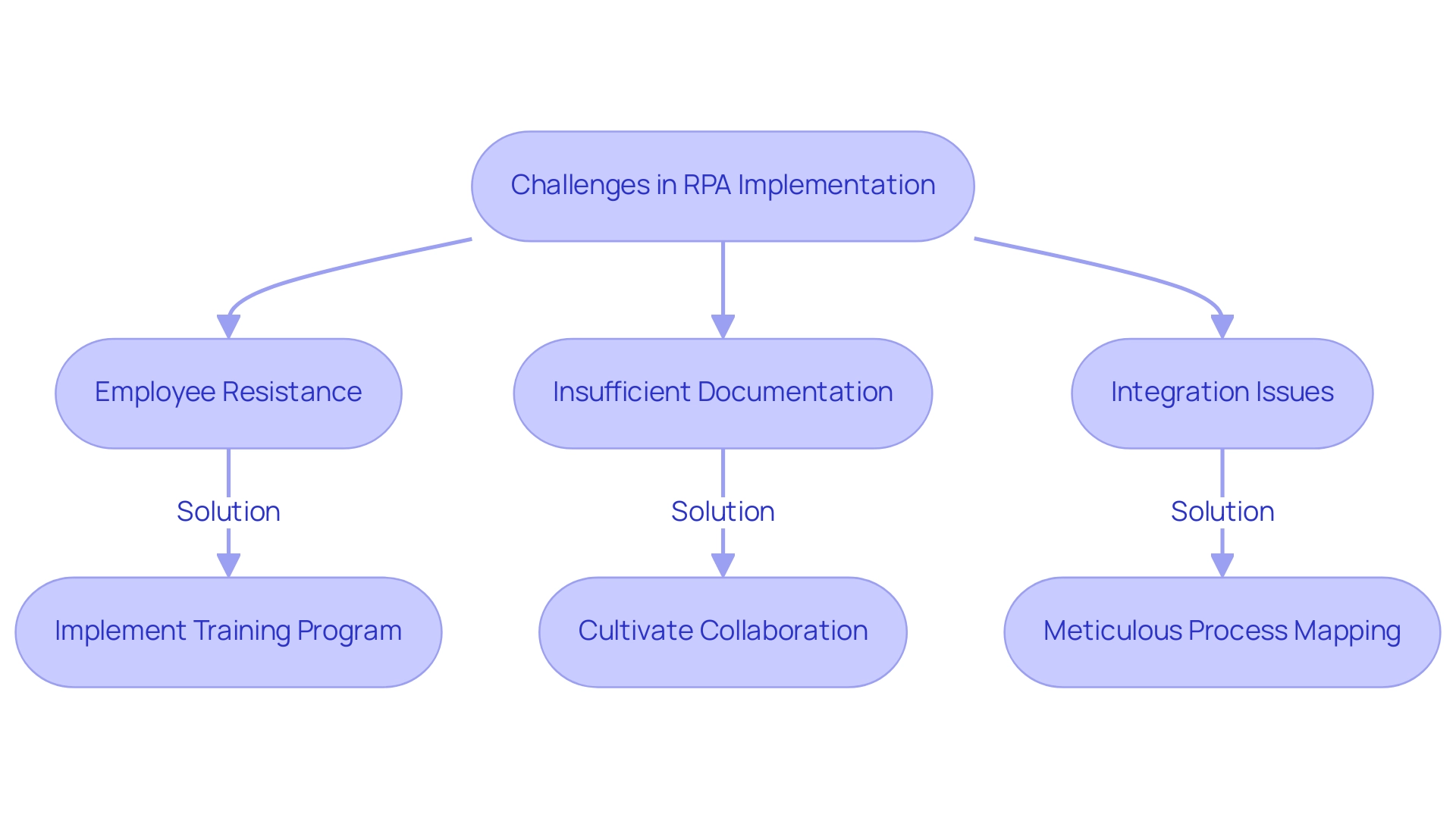
The Future of RPA: Trends and Innovations
The future of Robotic Process Automation (RPA) is undeniably promising, characterized by a wave of continuous innovations poised to significantly enhance its capabilities. One of the most noteworthy emerging trends is the integration of artificial intelligence and machine learning, which empowers RPA systems to tackle increasingly complex tasks and make informed, data-driven decisions. This evolution results in the emergence of intelligent systems, a model that combines RPA with cognitive technologies, enabling smooth execution of end-to-end tasks.
As highlighted by the recent push towards hyperautomation, businesses are increasingly focused on fully automating their operations, thereby improving workflows and allowing individuals to concentrate on more creative and strategic tasks. Such mechanization not only alleviates the challenges of poor master data quality—such as inconsistent, incomplete, or flawed data—but also tackles the common hesitations entities face regarding AI adoption, including uncertainties about integration, implementation difficulties, and perceived expenses.
A pertinent case study on hyperautomation demonstrates how various automation tools are utilized to modify entire business operations, resulting in improved workflows, productivity, and informed decision-making. With 48 percent of entities planning to integrate RPA and business process management into a singular Intelligent Automation platform, staying informed about these trends is essential for any Director of Operations Efficiency aiming to leverage the full potential of RPA within their operations.
As Ganesh Sankaralingam, delivery head at LatentView Analytics, emphasizes, augmented intelligence will be crucial in managing the vast amounts of data while delivering exceptional customer experiences that traditional AI solutions may overlook.
Looking ahead to 2024, specific trends in RPA technology advancements include:
- Enhanced cognitive capabilities
- Greater interoperability between systems
- More sophisticated data analytics tools
All of which will further empower organizations to optimize their operations and achieve a competitive edge.
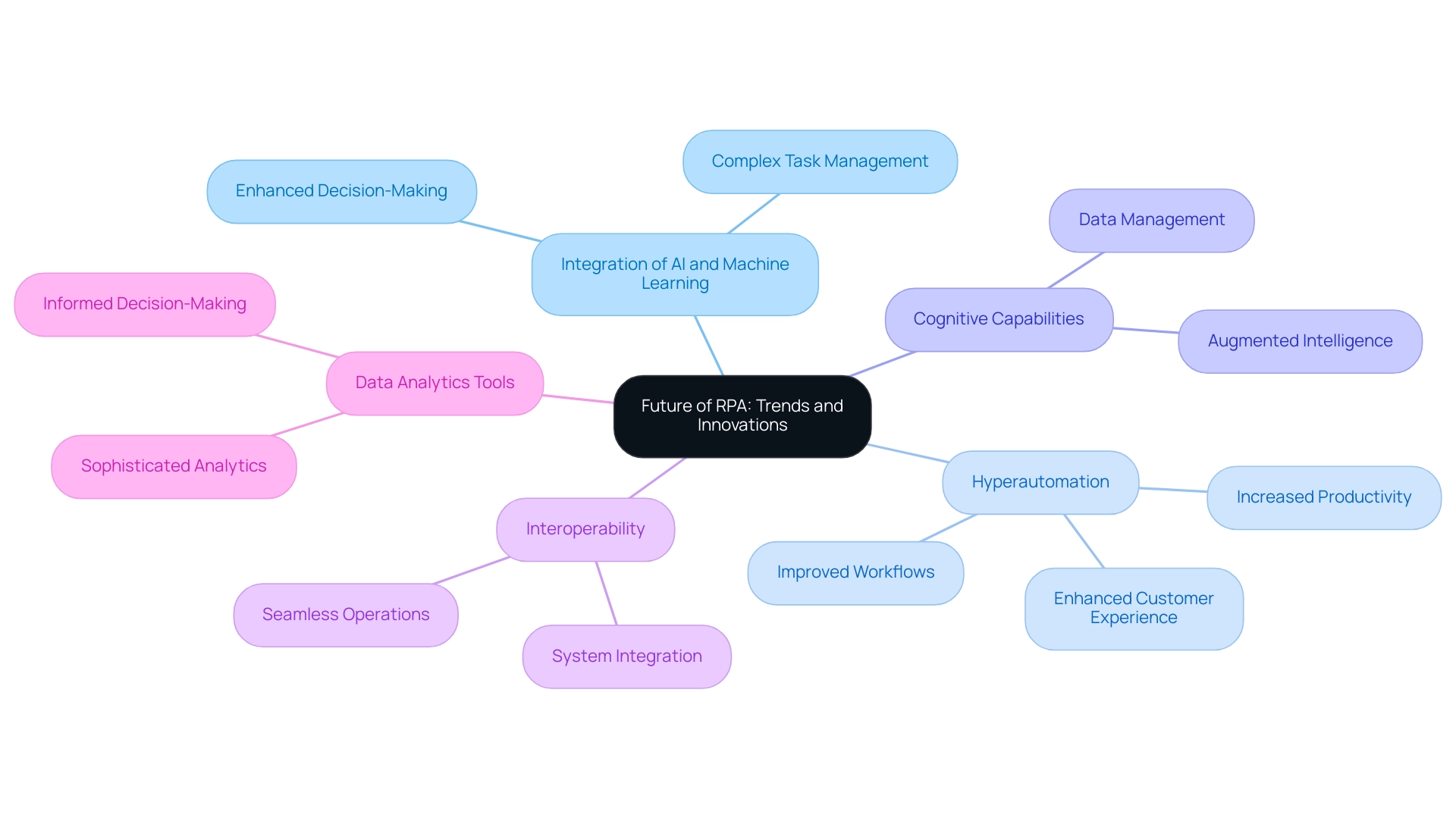
Conclusion
Robotic Process Automation (RPA) is transforming the way organizations operate by automating repetitive tasks, which not only boosts productivity but also allows human resources to engage in more strategic initiatives. The role of RPA developers is crucial in this landscape, as they design, implement, and maintain automation workflows that address operational challenges. With real-world examples showcasing significant improvements in efficiency and accuracy, the benefits of RPA implementation are clear: organizations can reduce errors, enhance compliance, and achieve rapid scalability.
However, the journey to successful RPA adoption is not without its challenges. Employee resistance, inadequate process documentation, and integration issues can hinder progress. It is essential for organizations to foster a culture of collaboration and communication, ensuring that employees understand the advantages of RPA.
Additionally, leveraging Business Intelligence tools can empower teams to make data-driven decisions, paving the way for a smoother implementation process.
Looking to the future, the integration of artificial intelligence and machine learning into RPA systems heralds a new era of intelligent automation. As businesses pursue hyperautomation, the focus will shift towards fully automating operations, ultimately enhancing workflows and enabling employees to concentrate on higher-level functions. Staying informed about emerging trends and innovations will be vital for leaders aiming to harness the full potential of RPA, ensuring their organizations remain competitive and resilient in an increasingly automated world.

